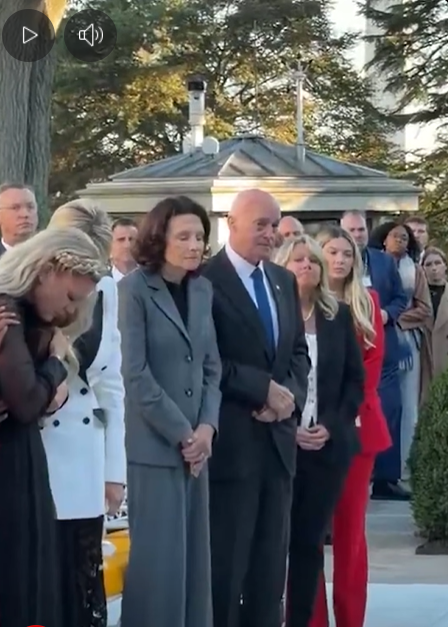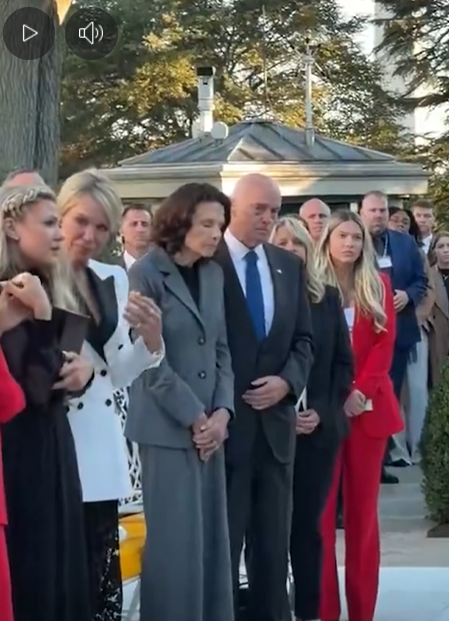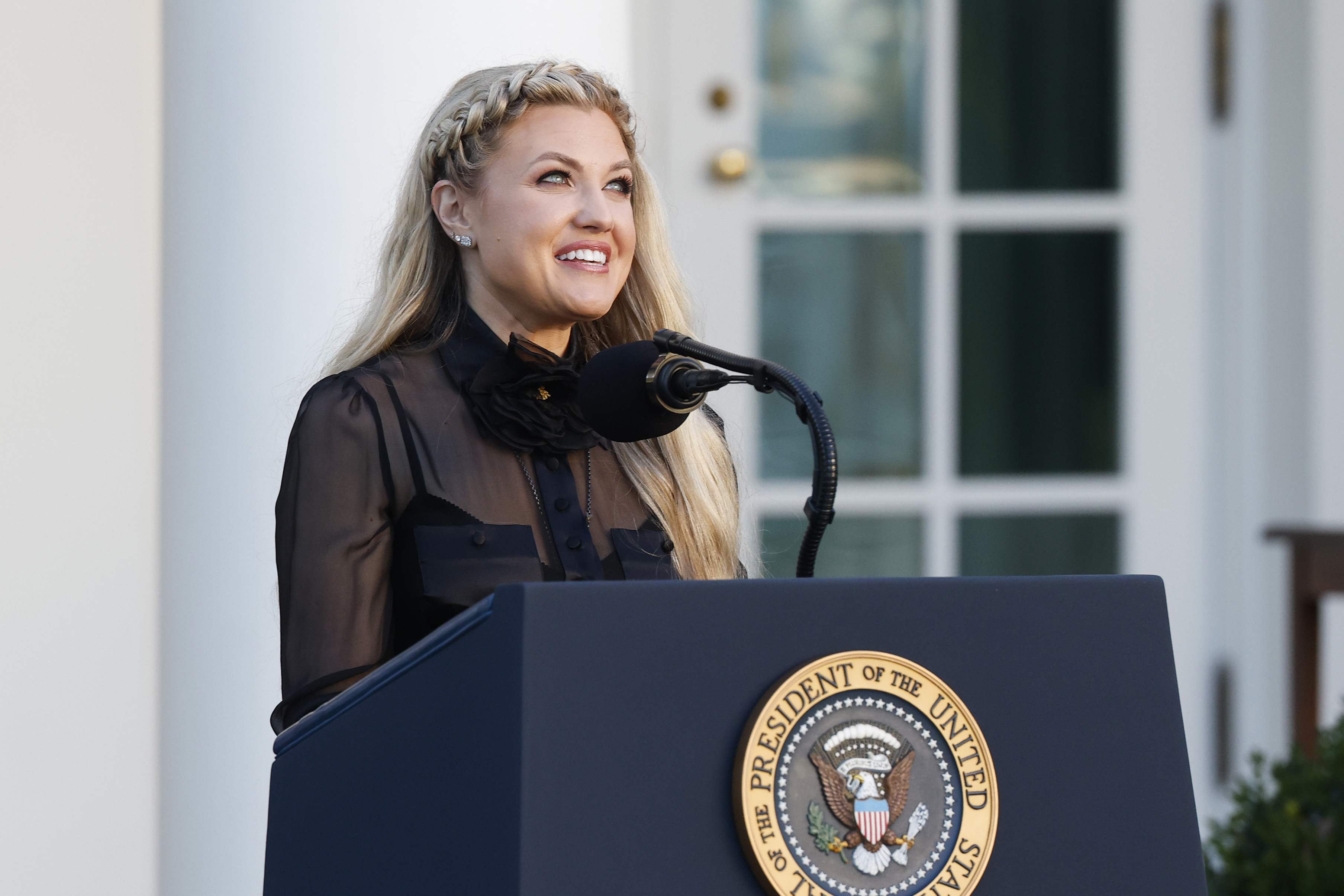A Ceremony to Honor Charlie Kirk’s Legacy Sparks Questions About Family, Faith, and the Public Face of Grief
What was meant to be a solemn tribute to the life and legacy of Charlie Kirk, the late conservative activist and commentator, has unexpectedly reignited public debate online. A video from the Presidential Medal of Freedom Ceremony at the White House — where Charlie’s widow, Erika Kirk, and his parents, Robert and Kathryn Kirk, gathered to accept the honor on his behalf — has drawn widespread attention, sparking emotional conversations about family dynamics, loss, and how grief is perceived in the public eye.

The moment should have been one of unity: a family brought together to honor a son, husband, and father who profoundly shaped American conservative youth movements. Instead, social media lit up with speculation over what the cameras appeared to capture — subtle gestures, distant stances, and expressions that viewers interpreted as signs of emotional separation.
A Ceremony of Legacy — and Subtle Distance

The event, held in the White House Rose Garden on October 14, 2025, was a formal recognition of Charlie Kirk’s years of political influence and activism. Dressed in a simple black dress, Erika Kirk stood among dignitaries and family, her posture composed and solemn. To her left, Robert and Kathryn Kirk, both visibly emotional, received quiet condolences from attendees.
But when footage from the ceremony surfaced on Facebook and X (formerly Twitter), online commentators began dissecting what they saw as the lack of closeness between Charlie’s widow and his parents. The clip, originally posted by a media outlet, went viral within hours, with hundreds of thousands of views and thousands of comments.
“It’s something so off-putting to see his parents embracing each other and his wife being embraced by others. They’re family, right? Just doesn’t look like family to me. More like strangers mourning someone,” one viewer wrote.
Another echoed that sentiment:
“As a mother-in-law, I can’t imagine not holding my daughter-in-law — the mother of my grandchildren — close at a moment like this. The distance says so much.”
Others noticed the positioning: Erika stood a few steps apart during portions of the ceremony. “Why aren’t they standing together? Most families would,” one user asked. “Why isn’t she next to or between his parents? Something feels off.”
Yet amid the speculation, a countercurrent of compassion also filled the comments section.
“This brought me to tears,” one user wrote. “Erika and Charlie’s parents showed such grace. Grief hits differently for everyone. Sometimes silence is love too.”
Another added, “You can see the heartbreak in Charlie’s mom. May God comfort them all — Erika, the children, and the parents. Losing someone like Charlie leaves a wound that never fully heals.”
The conflicting reactions highlight the paradox of public mourning in the social-media era: when grief is witnessed, it is also interpreted — and often, misunderstood.
Black Dress, White Suit — The Conversation Around Grieving in Public
Erika’s appearance at the White House was especially notable for her choice of attire. Clad in an elegant black dress — understated, respectful, and traditional — she presented an image of composure and quiet dignity. The choice seemed intentional, signaling the gravity of the moment. But it also reignited earlier debates surrounding her white outfit at her husband’s public memorial in Glendale, Arizona, held on September 21, 2025.
That earlier event, attended by thousands at State Farm Stadium, had gone viral for entirely different reasons. Instead of conventional mourning black, Erika appeared in a white tailored pantsuit, her long blonde hair falling in soft waves, her demeanor calm but emotional. Cameras captured her frequently dabbing her eyes with a tissue, but never losing composure.
Online reactions were immediate — and divided.
“Why didn’t she wear black?” one person asked. “When my grandfather passed, my grandmother wore black for a year. White just doesn’t feel appropriate.”
Another commenter wrote more sharply:
“She looked like she was attending a press event, not a memorial. It felt cold.”
Yet many came to Erika’s defense, praising her strength.
“She’s the strongest woman I’ve ever seen,” a supporter wrote. “Her faith is shining through her pain.”
“Wearing white is symbolic — it represents peace, purity, and the transition of the soul. I see it as an act of love, not disrespect.”
In interviews leading up to the memorial, Erika had shared that Charlie’s favorite color on her was white, which she chose to wear “not as defiance, but as light amid darkness.” The contrast between the two ceremonies — white at the memorial, black at the Medal of Freedom — has since become a symbolic throughline of how she continues to navigate life after loss.
A Pendant That Speaks Louder Than Words

Beyond attire, a far more intimate detail caught the attention of those present at both events: the pendant around Erika’s neck. It was not jewelry chosen for style — it was the St. Michael medal Charlie Kirk had been wearing on the night he died.
According to reports, paramedics had cut the pendant from around his neck as they worked to revive him. It bore a faint trace of blood, now barely visible, yet deeply significant to Erika. She has rarely been seen without it since.
Observers at the White House noted that the medal rested just above her heart as she stood during the ceremony. To many, it was a quiet statement that transcended fashion or public performance — a private token of devotion turned public symbol of enduring love.
One commenter on X wrote poignantly:
“The medal says everything words can’t. She carries him with her, even when the world keeps watching.”
Family Dynamics Under the Spotlight
Public fascination with Erika and Charlie’s family dynamic has persisted since his passing. The Kirks — a family that once seemed united in purpose and politics — have faced ongoing scrutiny as viewers dissect every appearance, post, and public statement.
At the Medal of Freedom ceremony, their physical distance from one another fueled assumptions of tension. Some wondered if differing beliefs, grief styles, or even unresolved disagreements had created a rift. Others suggested that what looked like detachment might simply have been solemn restraint in a high-profile setting.
Family grief experts have weighed in on similar cases before, noting that “grieving families often appear divided when they are, in fact, simply processing loss differently.” One may seek closeness; another may need silence. In the glare of public attention, those differences can appear amplified.
And in the case of the Kirks, every moment is captured, analyzed, and replayed — from facial expressions to gestures, every second becomes a narrative.
From Controversy to Compassion
Despite the debate, the White House ceremony also brought moments of shared reverence. When Erika took the podium to speak, her voice broke briefly before steadying.
“Charlie believed that truth and conviction mattered more than comfort,” she said. “He taught me — and all of us — to live with courage, even when it costs us.”
Her speech drew applause, and for a moment, the crowd stood in silence as she bowed her head. Cameras captured Robert and Kathryn Kirk wiping their eyes, the emotional distance between them and Erika seemingly narrowing in shared sorrow.
The viral clip’s aftermath online also took a more reflective tone as more viewers emphasized empathy over speculation. “Maybe they’re not distant,” one user wrote. “Maybe grief just looks different for each of them. Watching this reminded me that love doesn’t always show the same way.”
Mourning in the Age of Cameras
What the Medal of Freedom event and the Glendale memorial both reveal is the complex intersection of grief and visibility. When the private becomes public — whether by choice or circumstance — every decision is read as a statement.
The expectation that widows dress, cry, or stand a certain way reflects society’s deep discomfort with mourning that defies convention. Erika’s quiet composure has thus become both an object of admiration and controversy — a mirror reflecting the divided way the internet processes human pain.
In one interview months before the ceremony, Erika confessed,
“To this day, I can’t sleep in my bedroom. I keep rotating where I sleep. Some nights I feel strong. Some nights I feel empty. But I’m still here — for our children.”
That raw admission contrasts sharply with the poised public figure seen at national events. But together, they paint a fuller portrait: not of detachment, but of survival.
A Legacy Larger Than Loss
Though the online focus remains on perception, at the heart of these ceremonies lies the man they were meant to honor. Charlie Kirk — polarizing, influential, and passionate — built a national movement that inspired young conservatives to engage politically. The Medal of Freedom was a posthumous recognition of that legacy.
For his family, the award marked both an achievement and a wound reopened. For his widow, it was another test of grace under public gaze.
In the end, grief rarely unfolds neatly, and the internet rarely allows for quiet healing. Yet through it all, one image lingers — Erika standing beneath the October sky, hand resting over the pendant her husband once wore, holding both his memory and her composure with equal strength.
Whether viewed as cold distance or quiet endurance, that moment — like grief itself — remains open to interpretation.

Adrian Hawthorne is a celebrated author and dedicated archivist who finds inspiration in the hidden stories of the past. Educated at Oxford, he now works at the National Archives, where preserving history fuels his evocative writing. Balancing archival precision with creative storytelling, Adrian founded the Hawthorne Institute of Literary Arts to mentor emerging writers and honor the timeless art of narrative.
